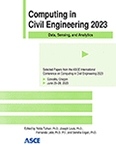Automatic Pixel-Level Detection of Structural Steel Elements Using U-Net and Transfer Learning
Publication: Computing in Civil Engineering 2023
ABSTRACT
Leveraging deep learning models to automatically detect structural steel elements at the pixel level from visual data can support many potential use cases for construction projects, including automated construction progress monitoring, quality control, safety monitoring, and perception systems for construction robotics. Many researchers have been applying deep learning models to detect various construction entities on sites. However, limited research has focused on detecting structural steel elements at the pixel level. This research focused on implementing U-Net, a state-of-the-art deep learning model for semantic segmentation, to segment steel beams, girders, and columns from construction images. All images were captured by a drone from a three-story steel building construction site. A data augmentation process was performed to increase the quantity of the training data. Two pre-trained convolutional neural networks (CNNs), VGG16 and ResNet50, were applied to the U-Net as backbones, respectively, for transfer learning purposes. The U-Net models with different backbones were trained using different sizes of the training data, and the performance was analyzed and compared. Four metrics were used to quantitatively analyze the model performance: precision, recall, F1-score, and Intersection over Union (IoU). This research found that the transfer learning technique improved the model performance by 2%−6%, depending on the analyzed metric. The data augmentation also slightly boosted the model performance. However, both transfer learning and data augmentation increased the overfitting issue. The future work includes combining the segmented steel elements with the as-designed building information modeling (BIM) for automated construction progress monitoring.
Get full access to this article
View all available purchase options and get full access to this chapter.
REFERENCES
Ai, D., Jiang, G., Lam, S.-K., He, P., and Li, C. (2020). “Automatic pixel-wise detection of evolving cracks on rock surface in video data.” Automation in Construction, 119: 103378. https://doi.org/10.1016/j.autcon.2020.103378.
Angah, O., and Chen, A. Y. (2020). “Removal of occluding construction workers in job site image data using U-Net based context encoders.” Automation in Construction, 119: 103332. https://doi.org/10.1016/j.autcon.2020.103332.
Belkin, M., Hsu, D., Ma, S., and Mandal, S. (2019). “Reconciling modern machine learning practice and the bias-variance trade-off.” Proc. Natl. Acad. Sci. U.S.A., 116 (32): 15849–15854. https://doi.org/10.1073/pnas.1903070116.
Chen, M., Feng, A., McCullough, K., Prasad, P., Mcalinden, R., and Soibelman, L. (2020). “3D Photogrammetry Point Cloud Segmentation Using a Model Ensembling Framework.” Journal of Computing in Civil Engineering, 34. https://doi.org/10.1061/(ASCE)CP.1943-5487.0000929.
Deng, J., Dong, W., Socher, R., Li, L.-J., Li, K., and Li, F.-F. (2009). “ImageNet: A large-scale hierarchical image database.” 2009 IEEE Conference on Computer Vision and Pattern Recognition, 248–255.
Garilli, E., Bruno, N., Autelitano, F., Roncella, R., and Giuliani, F. (2021). “Automatic detection of stone pavement’s pattern based on UAV photogrammetry.” Automation in Construction, 122: 103477. https://doi.org/10.1016/j.autcon.2020.103477.
Guan, J., Yang, X., Ding, L., Cheng, X., Lee, V. C. S., and Jin, C. (2021). “Automated pixel-level pavement distress detection based on stereo vision and deep learning.” Automation in Construction, 129: 103788. https://doi.org/10.1016/j.autcon.2021.103788.
He, K., Zhang, X., Ren, S., and Sun, J. (2015). “Deep Residual Learning for Image Recognition.”.
Katsamenis, I., Doulamis, N., Doulamis, A., Protopapadakis, E., and Voulodimos, A. (2022). “Simultaneous Precise Localization And Classification of metal rust defects for robotic-driven maintenance and prefabrication using residual attention U-Net.” Automation in Construction, 137: 104182. https://doi.org/10.1016/j.autcon.2022.104182.
Liu, Z., Cao, Y., Wang, Y., and Wang, W. (2019). “Computer vision-based concrete crack detection using U-net fully convolutional networks.” Automation in Construction, 104: 129–139. https://doi.org/10.1016/j.autcon.2019.04.005.
Loverdos, D., and Sarhosis, V. (2022). “Automatic image-based brick segmentation and crack detection of masonry walls using machine learning.” Automation in Construction, 140: 104389. https://doi.org/10.1016/j.autcon.2022.104389.
Pan, G., Zheng, Y., Guo, S., and Lv, Y. (2020). “Automatic sewer pipe defect semantic segmentation based on improved U-Net.” Automation in Construction, 119: 103383. https://doi.org/10.1016/j.autcon.2020.103383.
Perry, B. J., Guo, Y., and Mahmoud, H. N. (2022). “Automated site-specific assessment of steel structures through integrating machine learning and fracture mechanics.” Automation in Construction, 133: 104022. https://doi.org/10.1016/j.autcon.2021.104022.
Ronneberger, O., Fischer, P., and Brox, T. (2015). “U-Net: Convolutional Networks for Biomedical Image Segmentation.”.
Simonyan, K., and Zisserman, A. (2015). “Very Deep Convolutional Networks for Large-Scale Image Recognition.”.
Information & Authors
Information
Published In
History
Published online: Jan 25, 2024
ASCE Technical Topics:
- Architectural engineering
- Artificial intelligence and machine learning
- Automation and robotics
- Building information modeling
- Building management
- Computer programming
- Computing in civil engineering
- Construction (by type)
- Construction engineering
- Construction management
- Construction sites
- Design (by type)
- Engineering fundamentals
- Engineering materials (by type)
- Materials engineering
- Metals (material)
- Neural networks
- Steel
- Steel construction
- Steel structures
- Structural design
- Structural engineering
- Structural safety
- Structural steel
- Structures (by type)
- Systems engineering
Authors
Metrics & Citations
Metrics
Citations
Download citation
If you have the appropriate software installed, you can download article citation data to the citation manager of your choice. Simply select your manager software from the list below and click Download.
